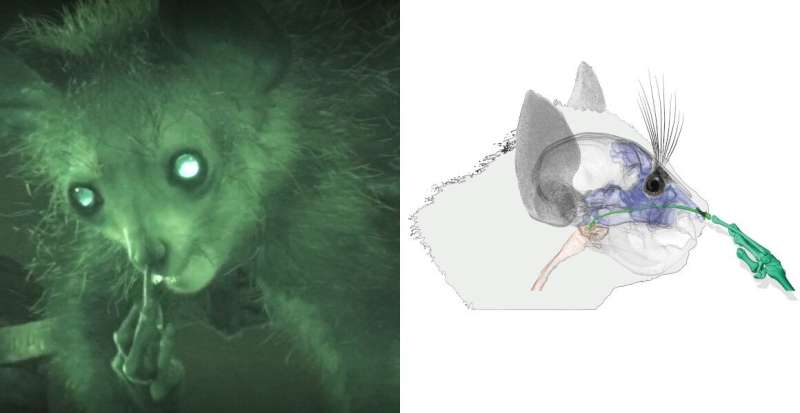Aye-ayes observed nose-picking, booger-eating for the first time

Nose picking might be thought of as a socially unacceptable behavior among humans but amazingly we are one of 12 species of primate to exhibit this habit. Today a new paper has revealed this behavior in aye-ayes for the first time.
The aye-aye is a species of strepsirrhine primate closely related to lemurs and the largest nocturnal primate in the world. In folklore they have received an ugly and undeserved reputation as harbingers of death and as such have often been killed on sight in some countries. The myth in part comes from their highly specialized and elongated finger, that legend says they use to point at those marked for death.
In truth, the third and fourth fingers (middle and ring fingers) of the aye-aye are elongated and skinny and are highly specialized to help them feed. Amazingly the fingers make up about 65% of the length of the hand with the hand itself making up over 40% of the total length of the forelimb. Aye-ayes use these adaptations to find food by tapping on wood, generating acoustic reverberations, which allow them to locate grubs inside which they can then extract with the specialized digits.
Lead author Anne-Claire Fabre is curator of mammals at the Naturhistorisches Museum der Burgergemeinde Bern and associate professor at the University of Bern, as well as a Scientific Associate of the Natural History Museum. She noticed the more novel use of the aye-aye's long middle finger when filming their behavior at the Duke Lemur center, a research foundation in North Carolina.
Anne-Claire says, "It was impossible not to notice this aye-aye picking its nose. This was not just a one-off behavior but something that it was fully engaged in, inserting its extremely long finger a surprisingly long way down its nose and then sampling whatever it dug up by licking its finger clean."
"There is very little evidence about why we, and other animals, pick our nose. Nearly all the papers that you can find were written as jokes. Of the serious studies, there are a few in the field of psychology, but for biology there's hardly anything. One study shows that picking your nose can spread bacteria such as Staphylococcus, while another shows that people who eat their own snot have fewer dental cavities."
Previous studies on the subject have suggested that the ingestion of nasal mucus could play an important role in the immune system and also it could prevent bacteria from sticking to tooth surfaces therefore improving oral health.
This new paper aims to consolidate the few research papers that cover nose-picking in primates into one place as well as providing photographic and video evidence of the behavior in aye-ayes for the first time. In doing this the team discovered that nose picking has been documented in at least 12 primate species including humans, chimpanzees and orangutans.
To better understand this behavior the research team also CT-scanned the skull and hand of an aye-aye specimen to reconstruct the position of the middle finger inside the nasal cavity. These reconstructions suggested that the finger is likely to descend all the way into the throat.
Roberto Portela Miguez, Senior Curator in Charge, Mammals, at the Museum and a co-author on the new paper says, "It is great to see how museum specimens and digital methods can help us elucidate behaviors that are generally quite difficult to observe in their natural habitat. We hope that future studies will build on this work and help us understand why we and our closest relatives insist on picking our noses."
"Aye-ayes are highly endangered, and really need our help. Papers like this can hopefully help draw attention to the species, highlight how little we may know about them and get more people to support their conservation."
A final observation the team cited is that primates love for ingesting their own mucus may simply be down to its texture, crunchiness and saltiness meaning this clever trick may reward them with a treat.
The study, "A review of nose picking in primates with new evidence of its occurrence in Daubentonia madagascariensis," is published in the Journal of Zoology.
More information: A.‐C. Fabre et al, A review of nose picking in primates with new evidence of its occurrence in Daubentonia madagascariensis, Journal of Zoology (2022). DOI: 10.1111/jzo.13034
Journal information: Journal of Zoology
Provided by Natural History Museum
This story is republished courtesy of Natural History Museum. Read the original story here.





















